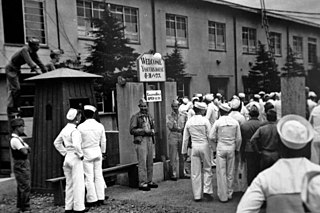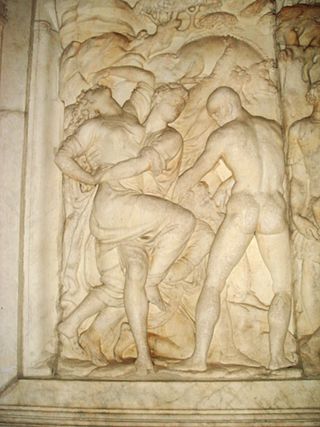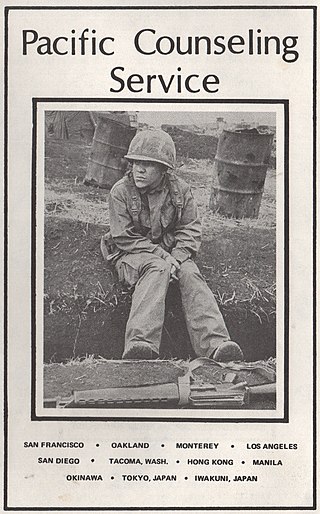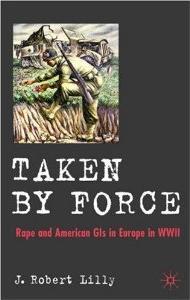
Edward Donald Slovik was a United States Army soldier during World War II and the only American soldier to be court-martialled and executed for desertion since the American Civil War. Although over 21,000 American soldiers were given varying sentences for desertion during World War II, including 49 death sentences, Slovik's death sentence was the only one that was carried out.

The United Service Organizations Inc. (USO) is an American nonprofit-charitable corporation that provides live entertainment, such as comedians, actors and musicians, social facilities, and other programs to members of the United States Armed Forces and their families. Since 1941, it has worked in partnership with the Department of War, and later with the Department of Defense (DoD), relying heavily on private contributions and on funds, goods, and services from various corporate and individual donors. Although it is congressionally chartered, it is not a government agency.

The Recreation and Amusement Association or RAA, was the largest of the organizations established by Japanese authorities to provide organized prostitution to prevent rapes and sexual violence by Allied occupation troops on the general population, and to create other leisure facilities for occupying Allied troops immediately following World War II. The RAA "recruited" 55,000 women and was short-lived.

The Manila massacre, also called the Rape of Manila, involved atrocities committed against Filipino civilians in the City of Manila, the capital of the Philippines, by Japanese troops during the Battle of Manila which occurred during World War II. At least 100,000 civilians were killed in total during the battle from all causes including the massacre by Japanese troops.
During World War II, the Allies committed legally proven war crimes and violations of the laws of war against either civilians or military personnel of the Axis powers. At the end of World War II, many trials of Axis war criminals took place, most famously the Nuremberg Trials and Tokyo Trials. In Europe, these tribunals were set up under the authority of the London Charter, which only considered allegations of war crimes committed by people who acted in the interests of the Axis powers. Some war crimes involving Allied personnel were investigated by the Allied powers and led in some instances to courts-martial. Some incidents alleged by historians to have been crimes under the law of war in operation at the time were, for a variety of reasons, not investigated by the Allied powers during the war, or were investigated but not prosecuted.

During World War II, the German Wehrmacht committed systematic war crimes, including massacres, mass rape, looting, the exploitation of forced labour, the murder of three million Soviet prisoners of war, and participated in the extermination of Jews. While the Nazi Party's own SS forces was the organization most responsible for the genocidal killing of the Holocaust, the regular armed forces of the Wehrmacht committed many war crimes of their own, particularly on the Eastern Front.

G.I. Combat is an American comics anthology featuring war stories. It was published from 1952 until 1956 by Quality Comics, followed by DC Comics until its final issue in 1987. In 2012 it was briefly revived.

Louis Till was an African American GI during World War II. After enlisting in the United States Army following trial for domestic violence against his estranged wife Mamie Till, and having chosen military service over jail time, Till was court-martialed on two counts of rape and one count of murder during the Italian Campaign. He was found guilty and was executed by hanging at Aversa. Till was the estranged father of Emmett Till, whose murder in August 1955 at the age of 14 galvanized the civil rights movement. The circumstances of Till's death remained largely unknown until they were revealed after the highly controversial acquittal of his son's murderers ten years later.
The aftermath of World War II saw the rise of two global superpowers, the Soviet Union (USSR) and the United States (US). The aftermath of World War II was also defined by the rising threat of nuclear warfare, the creation and implementation of the United Nations as an intergovernmental organization, and the decolonization of Asia and Africa by European and East Asian powers, most notably by the United Kingdom, France, and Japan.

Wartime sexual violence is rape or other forms of sexual violence committed by combatants during an armed conflict, war, or military occupation often as spoils of war, but sometimes, particularly in ethnic conflict, the phenomenon has broader sociological motives. Wartime sexual violence may also include gang rape and rape with objects. It is distinguished from sexual harassment, sexual assaults and rape committed amongst troops in military service.
Members of the United States Armed Forces have violated the law of war after the signing of the Hague Conventions of 1899 and 1907 and the signing of the Geneva Conventions. The United States prosecutes offenders through the War Crimes Act of 1996 as well as through articles in the Uniform Code of Military Justice. The United States signed the 1999 Rome Statute but it never ratified the treaty, taking the position that the International Criminal Court (ICC) lacks fundamental checks and balances. The American Service-Members' Protection Act of 2002 further limited US involvement with the ICC. The ICC reserves the right of states to prosecute war crimes, and the ICC can only proceed with prosecution of crimes when states do not have willingness or effective and reliable processes to investigate for themselves. The United States says that it has investigated many of the accusations alleged by the ICC prosecutors as having occurred in Afghanistan, and thus does not accept ICC jurisdiction over its nationals.
Allied and Japanese troops committed a number of rapes during the Battle of Okinawa during the last months of the Pacific War and the subsequent Allied occupation of Japan. The Allies occupied Japan until 1952 following the end of World War II and Okinawa Prefecture remained under US governance for two decades after.

As Allied troops entered and occupied German territory during the later stages of World War II, mass rapes of women took place both in connection with combat operations and during the subsequent occupation of Germany by soldiers from all advancing Allied armies, although a majority of scholars agree that the records show that a majority of the rapes were committed by Soviet occupation troops. The wartime rapes were followed by decades of silence.
Brown Babies is a term used for children born to black soldiers and white women during and after the Second World War. Other names include "war babies" and "occupation babies." In Germany they were known as Mischlingskinder, a term first used under the Nazi regime for children of mixed Jewish-German parentage. As of 1955, African-American soldiers had fathered about 5,000 children in the American Zone of Occupied Germany. In Occupied Austria, estimates of children born to Austrian women and Allied soldiers ranged between 8,000 and 30,000, perhaps 500 of them biracial. In the United Kingdom, West Indian members of the British military, as well as African-American soldiers in the US Army, fathered 2,000 children during and after the war. A much smaller and unknown number, probably in the low hundreds, was born in the Netherlands, but the lives of some have been followed into their old age and it is possible to have a better understanding of the experience that would unfold for all of the Brown Babies of World War II Europe.
U.S. soldiers committed rape against French women during and after the liberation of France in the later stages of World War II. The sociologist J. Robert Lilly of Northern Kentucky University estimates that U.S. servicemen committed around 4,500 rapes in France between June 1944 and the end of the war in May 1945.

GI coffeehouses were coffeehouses set up as part of the anti-war movement during the Vietnam War era as a method of fostering antiwar and anti-military sentiment within the U.S. military. They were mainly organized by civilian antiwar activists, though many GIs participated in establishing them as well. They were created in numerous cities and towns near U.S. military bases throughout the U.S as well as Germany and Japan. Due to the normal high turnover rate of GIs at military bases plus the military's response which often involved transfer, discharge and demotion, not to mention the hostility of the pro-military towns where many coffeehouses were located, most of them were short-lived, but a few survived for several years and "contributed to some of the GI movement's most significant actions". The first GI coffeehouse of the Vietnam era was set up in January 1968 and the last closed in 1974. There have been a few additional coffeehouses created during the U.S. led wars in Iraq and Afghanistan.

The Pacific Counseling Service (PCS) was a G.I. counseling service organization created by antiwar activists during the Vietnam War. PCS saw itself as trying to make the U.S. Armed Forces "adhere more closely to regulations concerning conscientious objector discharges and G.I. rights." The Armed Forces Journal, on the other hand, said PCS was involved in "antimilitary activities", including "legal help and incitement to dissident GIs." PCS evolved out of a small GI Help office started by a freshly discharged Air Force Sergeant in San Francisco, California in January 1969. The idea rapidly caught on among antiwar forces and within a year PCS had offices in Monterey, Oakland, and San Diego in California, plus Tacoma, Washington. By 1971 it had spread around the Pacific with additional offices in Los Angeles, Hong Kong, Okinawa, the Philippines, as well as Tokyo and Iwakuni in Japan. Each location was established near a major U.S. military base. At its peak, PCS was counseling hundreds of disgruntled soldiers a week, helping many with legal advice, conscientious objector discharges and more. As the war wound down, ending in 1975, the offices closed with the last office in San Francisco printing its final underground newspaper in 1976.

The GI Underground Press was an underground press movement that emerged among the United States military during the Vietnam War. These were newspapers and newsletters produced without official military approval or acceptance; often furtively distributed under the eyes of "the brass". They were overwhelmingly antiwar and most were anti-military, which tended to infuriate the military command and often resulted in swift retaliation and punishment. Mainly written by rank-and-file active duty or recently discharged GIs, AWOLs and deserters, these publications were intended for their peers and spoke the language and aired the complaints of their audience. They became an integral and powerful element of the larger antiwar, radical and revolutionary movements during those years. This is a history largely ignored and even hidden in the retelling of the U.S. military's role in the Vietnam War.

Soldiers in Revolt: GI Resistance During the Vietnam War was the first comprehensive exploration of the disaffection, resistance, rebellion and organized opposition to the Vietnam War within the ranks of the U.S. Armed Forces. It was the first book written by David Cortright, a Vietnam veteran who is currently Professor Emeritus and special adviser for policy studies at the Keough School of Global Affairs and Kroc Institute for International Peace Studies at the University of Notre Dame, and the author, co-author, editor or co-editor of 22 books. Originally published as the war was ending in 1975, it was republished in 2005 with an introduction by the well known progressive historian Howard Zinn. Despite being first published 49 years ago, it remains the definitive history of this often ignored subject. The book argues persuasively, with encyclopedic rigor, the still under appreciated fact that by the early 1970s the U.S. armed forces, particularly its ground forces, were essentially breaking down; experiencing a deep crises of moral, discipline and combat effectiveness. Cortright reveals, for example, that in fiscal year 1972, there were more conscientious objectors than draftees, and precipitous declines in both officer enrollments and non-officer enlistments. He also documents "staggering level[s]" of desertions, increasing nearly 400% in the Army from 1966 to 1971. Perhaps more importantly, Cortright makes a convincing case for this unraveling being both a product and an integral part of the anti-Vietnam War sentiment and movement widespread within U.S. society and worldwide at the time. He documents hundreds of GI antiwar and antimilitary organizations, thousands of individual and group acts of resistance, hundreds of GI underground newspapers, and highlights the role of Black GIs militantly fighting racism and the war. This is where the book stands alone as the first and most systematic study of the antiwar and dissident movements impact and growth within the U.S. armed forces during the Vietnam War. While other books, articles and studies have examined this subject, none have done it as thoroughly and systematically.













